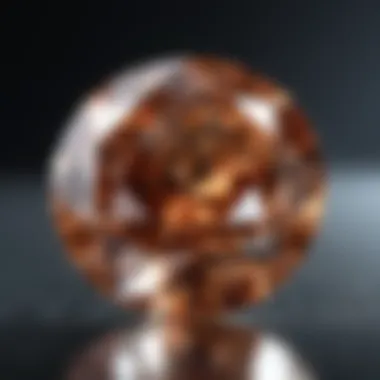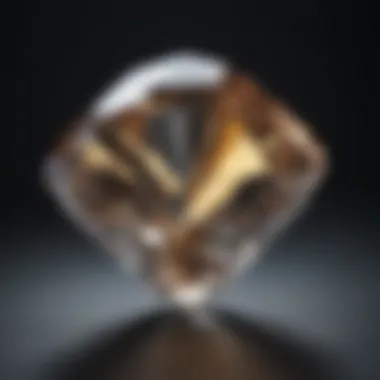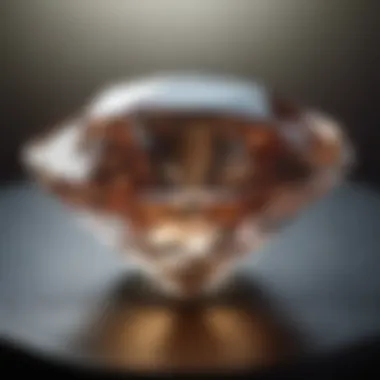Unveiling the Secrets of Diamond Metrics: An In-Depth Exploration


Overview of Gemstones and Minerals
Gemstones and minerals have long held a significant place in human history, praised for their beauty and prized for their scarcity. Society's fascination with these natural wonders transcends mere aesthetics, delving into the cultural and social realms. Throughout the ages, gemstones and minerals have adorned royalty, symbolized power, and embodied status, making them integral to the tapestry of human civilization. From ancient civilizations to modern societies, the allure of gemstones and minerals remains unyielding.
Gemstone Formation and Properties
The formation of gemstones is a mesmerizing process that unfolds over millions of years, deep within the Earth's crust. Through a complex interplay of pressure, temperature, and geological forces, raw minerals metamorphose into exquisite gemstones. These gemstones exhibit a myriad of properties that define their uniqueness, such as color, hardness, and luster. Each gemstone's distinct personality emerges through its individual characteristics, reflecting the intricate dance of nature's elements.
Types of Gemstones
In the realm of gemstones, a dichotomy exists between precious and semi-precious categories, delineating their rarity and market value. Precious gemstones, like diamonds, rubies, sapphires, and emeralds, occupy the upper echelons of the gem kingdom, revered for their exceptional beauty and scarcity. Conversely, semi-precious gemstones, including amethyst, citrine, and turquoise, offer a more accessible entry point into the world of fine jewelry. Beyond these categories lie exotic and rare gemstones that tantalize the senses with their unparalleled beauty and exclusivity.
Identifying and Evaluating Gemstones
Evaluating gemstones encompasses a meticulous process that takes into account various factors influencing their value and quality. From the 4 Cs of diamonds—cut, color, clarity, and carat weight—to gemstone-specific characteristics like fluorescence and inclusions, a trained eye can discern the intricacies of each precious stone. Techniques for gemstone identification rely on a blend of scientific analysis, gemological knowledge, and practical experience, enabling gemologists to authenticate and assess the quality of gemstones accurately.
Caring for Gemstones
Proper care and maintenance are essential to safeguard the beauty and integrity of gemstones for posterity. Cleaning gemstones requires gentle methods to preserve their brilliance and clarity, ensuring longevity and sheen. Storing gemstones in appropriate conditions shields them from environmental harm and premature wear, protecting their value over time. By adhering to best practices in gemstone care, enthusiasts can enjoy their treasures for generations, appreciating the timeless allure of these natural marvels.
Introduction to Diamond Measurement
In the vast landscape of gemology, the Introduction to Diamond Measurement serves as the foundational pillar that underpins the assessment of a diamond's quality and value. This section unravels the intricacies of carat weight, cut grade, clarity, and color, which collectively determine a diamond's allure and uniqueness. Understanding these essential elements provides insight into the complex world of diamond evaluation, aiding enthusiasts, collectors, jewelry designers, and geology aficionados in making informed decisions when selecting or analyzing diamonds.
Understanding Carat Weight


When delving into the realm of diamond assessment, one cannot overlook the paramount role played by carat weight. The Definition of Carat characterizes the weight of a diamond, where one carat equals 200 milligrams. This measurement not only denotes the physical mass of the diamond but also significantly influences its market value and desirability. The Significance of Carat Weight in Diamond Pricing further accentuates the correlation between weight and price, as consumers often perceive higher carat weights as indicators of luxury and prestige. Despite its influence on pricing, the Impact of Carat Weight on Diamond Size showcases how carat weight alone does not determine a diamond's physical dimensions, emphasizing the importance of cut and shape in achieving desired sizes.
Exploring Cut Grade
In the domain of diamonds, cut grade stands as a cornerstone in defining a stone's brilliance and fire. The Importance of Cut in Diamond Brilliance highlights how a diamond's cut directly impacts its ability to reflect light, enhancing its overall sparkle and scintillation. Understanding the nuances of Different Cut Grades and Their Characteristics reveals the spectrum of cut qualities, ranging from poor to excellent, with each grade influencing the diamond's visual appeal. Evaluating Cut Precision and Craftsmanship delves into the meticulous artistry required in creating a precise cut that maximizes a diamond's beauty, emphasizing the role of skilled craftsmanship in enhancing a stone's brilliance.
Deciphering Diamond Clarity
Clarity, a crucial aspect of diamond assessment, refers to the presence of inclusions and blemishes within a stone. The Definition of Clarity sheds light on how gemologists categorize the purity of diamonds based on the visibility of these imperfections, affecting both the stone's aesthetics and value. Delving deeper, Types of Inclusions and Blemishes elucidate the various internal and external flaws that can diminish a diamond's clarity grade, highlighting the importance of clarity enhancement techniques in the jewelry industry. Grading Systems for Diamond Clarity further refines the assessment process by providing standardized criteria for evaluating the severity of inclusions, facilitating accurate comparisons between different stones.
Unveiling Diamond Color
Among the spectrum of diamond characteristics, color plays a significant role in determining a stone's rarity and value. The Grading Scale for Diamond Color establishes a standardized method for categorizing a diamond's colorlessness, with D representing the highest level of colorlessness. Exploring the Impact of Color on Diamond Value underscores how subtle variations in color can greatly impact a diamond's market worth, with fancy colored diamonds commanding unique appeal and premium prices. Rare and Fancy Colored Diamonds introduce an element of exclusivity to the diamond world, showcasing the beauty and allure of stones that deviate from traditional colorless variations.
Advanced Metrics in Diamond Assessment
Importance of topic Advanced Metrics in Diamond Assessment in this article:
In the realm of diamonds, delving into advanced metrics is paramount for a nuanced evaluation of a diamond's quality and value. These metrics go beyond the traditional factors like carat weight, cut grade, and clarity, allowing an in-depth analysis that distinguishes exceptional diamonds from the rest. Understanding advanced metrics provides a holistic view of a diamond's characteristics, enabling informed decisions and precise comparisons. With the complexities of the diamond industry continuously evolving, mastering advanced metrics is indispensable for both buyers and sellers seeking superior diamonds.
Assessing Diamond Symmetry
- Symmetry Criteria in Diamond Evaluation:
Symmetry Criteria in Diamond Evaluation:
Exploring the symmetry of a diamond is a crucial aspect of its evaluation process. Symmetry plays a pivotal role in enhancing a diamond's brilliance and overall visual appeal. It refers to the alignment and balance of facets, contributing to the diamond's optical performance and light reflection. Symmetry criteria are essential for assessing a diamond's craftsmanship and precision, reflecting the skill and artistry of its cutting. For this article, delving into symmetry criteria sheds light on how meticulous detailing impacts a diamond's allure and value, offering readers a deeper appreciation for the intricate art of diamond cutting.


- Effects of Symmetry on Diamond Appearance:
Effects of Symmetry on Diamond Appearance:
Symmetry significantly influences how light interacts with a diamond, affecting its fire and scintillation. A diamond with precise symmetry exhibits optimal light reflection and refraction, resulting in a stunning display of brilliance. The effects of symmetry on a diamond's appearance are unmistakable, showcasing symmetry's direct correlation with visual charm and elegance. Understanding how symmetry enhances diamond aesthetics is essential for discerning enthusiasts aiming to acquire exceptional gemstones.
- Symmetry Grading Parameters:
Symmetry Grading Parameters:
Grading symmetry involves evaluating specific parameters that determine the overall symmetry quality of a diamond. These parameters encompass factors like facet alignment, facet shape consistency, and overall facet proportions. The symmetry grading parameters serve as a standardized method for quantifying the symmetry aspects of a diamond, facilitating objective comparisons across various diamonds. Discussing these parameters in detail within this article equips readers with the knowledge to discern superior symmetry characteristics, aiding them in making informed purchasing decisions.
Measuring Diamond Fluorescence
- Causes and Effects of Diamond Fluorescence
- Grading Fluorescence Intensity
- Influence of Fluorescence on Diamond Sparkle
Causes and Effects of Diamond Fluorescence
Understanding Diamond Polish
- Role of Polish in Diamond Luster
- Evaluating Polish on Diamond Refraction
- Impact of Polish provided by따 Diamond Refraction
Role of Polish in Diamond Luster
Examining Diamond Table and Depth Percentages


- Definition of Table.exe and Depth Percentages
- Ideal Proportions for Optimal Diamond sales- Calculating Table and Depth s thatios
Definition of Table.exe and Depth Percentages
Ideal Proportions for Optimal Diamond sales- Calculating Table and Depth s thatios
Diamond Grading Laboratories and Certifications
When delving into the realm of diamond evaluation, understanding the significance of Diamond Grading Laboratories and Certifications is paramount. These entities act as the pillars of trust and authenticity in the diamond industry. Within this article, we will dissect the crucial role these laboratories and certifications play in ensuring the quality and value of diamonds.
Leading Diamond Grading Institutes
- GIA (Gemological Institute of America): The GIA stands as a beacon of excellence in diamond grading, known for its stringent standards and rigorous certification processes. This institute's commitment to research and education elevates its credibility, making it a preferred choice for many in the industry. The GIA's emphasis on accuracy and consistency sets it apart from others, although some may find its services relatively more expensive than alternative options.
- AGS (American Gem Society): Within the diamond grading landscape, the AGS shines brightly due to its focus on consumer protection and ethical practices. This institute's dedication to consumer education and cut grading innovations makes it a sound choice for those seeking transparency and reliability. However, AGS's narrower focus compared to GIA may influence the breadth of services it offers in this context.
- EGL (European Gemological Laboratory): The EGL's global presence and extensive network position it as a key player in the grading realm. Its adaptability to various markets and cost-effective solutions appeal to a wide range of consumers. Yet, some critics point out inconsistencies in grading standards across EGL branches, posing a consideration for those seeking cohesion in their certification processes.
Importance of Diamond Certificates
- Components of a Diamond Certificate: Diamond certificates encapsulate vital information about a diamond's characteristics and serve as a credential of its quality. This pivotal document aids in understanding a diamond's value and authenticity, making it an indispensable tool in the buying process.
- Validity and Reliability of Diamond Grading Reports: The validity and reliability of diamond grading reports underscore the trustworthiness of the certification process. Ensuring that reports are from reputable laboratories enhances buyer confidence and facilitates informed decision-making.
- Verifying Diamond Authenticity: Verifying a diamond's authenticity through certification mitigates the risk of purchasing counterfeit or misrepresented stones. By relying on accredited certification processes, buyers safeguard their investments and uphold the integrity of the diamond market.
Comparing Different Diamond Certifications
- GIA vs. AGS Certifications: Contrasting the GIA and AGS certifications sheds light on their respective strengths and approaches to diamond grading. While GIA emphasizes research and education, AGS prioritizes consumer awareness and protection. Understanding these distinctions assists individuals in selecting certifications aligning with their priorities and values.
- Understanding Discrepancies in Grading Reports: Recognizing and interpreting variations in grading reports is essential for informed decision-making. Discrepancies between reports from different laboratories can highlight the subjective nature of diamond grading, prompting individuals to evaluate grading criteria carefully.
- Choosing the Right Certification for Your Diamond: Selecting the appropriate certification for a diamond requires a comprehensive assessment of one's preferences and requirements. Factors such as budget, timeline, and desired level of detail influence this decision, necessitating a thoughtful approach to certification selection.
Conclusion: Mastering the Art of Diamond Evaluation
In the realm of diamond evaluation, the conclusion serves as the pinnacle of understanding, encapsulating the reader's journey through the intricate world of diamond metrics. As we navigate through the nuances of carat weight, cut grade, clarity, color, symmetry, fluorescence, polish, table and depth percentages, the final destination lies in mastering the art of diamond evaluation. This section not only summarizes the key elements discussed throughout this comprehensive guide but also illuminates the significance of honing one's skills in assessing diamond quality and value.
Delving into the realm of mastering the art of diamond evaluation, it becomes evident that attention to detail is paramount. By scrutinizing each aspect from carat weight to cut precision, clarity grading, color nuances, symmetry evaluation, fluorescence intensity, polish quality, and table and depth percentages, one can truly grasp the essence of what makes a diamond exceptional. mystals The in-depth exploration also sheds light on the interplay between these factors, illustrating how a harmonious balance magnifies a diamond's allure and brilliance.
As enthusiasts and collectors immerse themselves in the world of diamonds, the ability to master the art of evaluation brings forth manifold benefits. With acumen honed through understanding the complexities of diamond assessment, individuals can make informed decisions when selecting or appraising diamonds. Inightingful Moreover, this mastery enhances one's appreciation for the craftsmanship and artistry involved in creating each unique gem, elevating the experience of owning or designing jewelry.
Considerations regarding mastering the art of diamond evaluation extend beyond personal enrichment. Deepinedge For jewelry designers, this expertise opens doors to crafting exquisite pieces that showcase diamonds in their full splendor, accentuating their inherent beauty. Geology enthusiasts find a new perspective on the Earth's wonders, unraveling the geological processes that birth these coveted gemstones.
In essence, the conclusion is not just a closing remark; it represents a culmination of knowledge, experience, and passion for the cribingcharms mesmerizing world of diamonds. It encapsulates the essence of what it means to truly appreciate the value of these precious gems, providing a framework for continual learning and exploration in the realm of gemology.







